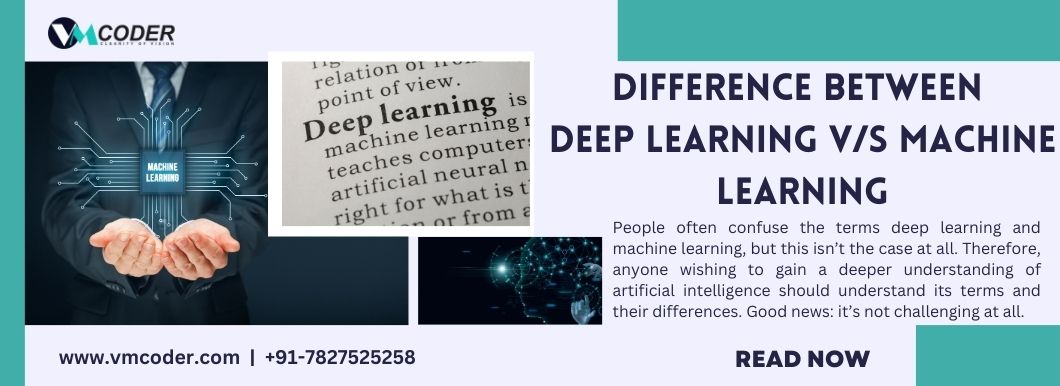Deep Learning Vs Machine Learning
In the world of artificial intelligence, two terms that are often used interchangeably but hold distinct meanings are "machine learning" and "deep learning." To truly grasp the intricacies of artificial intelligence, it is crucial to comprehend the differences between these two concepts. Luckily, delving into the subject isn't as challenging as it may initially seem. Deep learning is essentially a subfield of machine learning, encompassing sophisticated algorithms that have revolutionized the AI landscape.
Let's check more about Deep Learning and Machine Learning on website :-
Machine Learning: A Foundation for AI Advancement
At its core, machine learning refers to the process of teaching computers to learn from data and make predictions based on patterns it discovers. This intersection of computer science and statistics employs algorithmic approaches to achieve its objectives. Machine learning algorithms can be categorized into two main types: supervised and unsupervised learning.
Supervised learning involves training the algorithm using labeled data, where it learns to map input data to the corresponding output. On the other hand, unsupervised learning utilizes unlabeled data, enabling the algorithm to find patterns and structures within the data without explicit guidance.
Essentially, machine learning is an intricate form of mathematics translated into code, allowing computers to perform tasks as diverse as a flashlight illuminating a dark room, a car navigating through traffic, or a computer screen displaying vivid images.
Deep Learning: The Evolutionary Leap in AI
Deep learning takes the advancements of machine learning algorithms to a higher level of sophistication and complexity. Recent technological breakthroughs have resulted in unprecedented results and opened new frontiers for AI applications. Deep learning can utilize both supervised and unsupervised learning techniques.
At the heart of deep learning are artificial neural networks (ANNs), a structured set of algorithms inspired by the biological neural networks found in the human brain. These networks consist of layers that process and analyze data, enabling the algorithm to reason and make decisions in a manner similar to human cognitive processes. The multi-layered architecture of ANNs empowers deep learning to surpass conventional machine learning models in terms of capability and performance.
Today, deep learning finds application in various domains, such as automated driving, where it identifies objects like STOP signs and pedestrians through computer vision algorithms. In the military, deep learning is used to detect threats from satellites, assisting in determining safe and unsafe zones for troops. Additionally, consumer electronics like Amazon Alexa employ deep learning algorithms to respond to users' voices and personalize their preferences.
Machine Learning vs. Deep Learning: The Key Differences
While machine learning and deep learning share a common foundation, their abilities and operational mechanisms set them apart.
-
Decision-making Autonomy: In machine learning, models improve with time but still require human intervention when faced with incorrect predictions. In contrast, deep learning models can independently make decisions through their neural networks, enhancing their decision-making autonomy.
-
Data Analysis Efficiency: Deep learning algorithms excel at analyzing images, videos, and unstructured data, surpassing machine learning's capabilities in this regard. This efficiency stems from the multi-layered neural networks used in deep learning, allowing for more complex data processing.
-
Complexity and Hardware Requirements: Deep learning systems are more complex than machine learning programs and demand powerful hardware and resources for optimal performance. While machine learning algorithms are generally simpler and can be operated using conventional computers.
-
AI Advancement: Deep learning is the driving force behind the most human-like artificial intelligence, allowing machines to think and reason in a manner akin to the human brain. This has led to advancements in areas like self-driving cars and advanced robotic surgery.
-
Industry Relevance: Both machine learning and deep learning hold significant career potential across various industries, paving the way for exciting job opportunities in the field of artificial intelligence.
-
Application Domains: While machine learning primarily relies on structured data and linear regression, deep learning's neural networks enable it to handle vast volumes of unstructured data, making it more versatile in analyzing diverse data formats.
Looking Ahead: The Future of AI
The advancements in deep learning technology have paved the way for sophisticated and autonomous AI applications, such as self-driving cars and robots capable of performing complex surgeries. Machine learning, on the other hand, is already extensively integrated into various aspects of our daily lives, from personalized recommendations in our emails to secure financial transactions and efficient medical diagnoses.
As technology continues to evolve, both machine learning and deep learning will play vital roles in shaping the future of artificial intelligence. Whether it's making our lives more convenient or solving complex global challenges, these AI technologies will undoubtedly revolutionize the world in which we live.
Conclusion:
In conclusion, understanding the distinction between machine learning and deep learning is pivotal for anyone seeking a deeper comprehension of artificial intelligence. Machine learning serves as the foundation, while deep learning represents a remarkable evolution in AI capabilities. As technology advances further, the boundaries between the two may continue to blur, but their collective impact on society will remain transformative. Embracing these cutting-edge technologies will undoubtedly lead to exciting opportunities and advancements in various industries, ultimately shaping a future where AI plays an even more integral role in our lives.
Written by :
Shweta Bhatia
Leave a Reply
Your email address will not be published. Required fields are marked *






